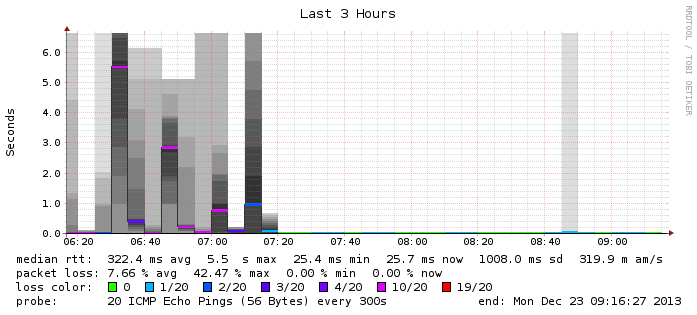I run a couple of Internet-facing servers for my website, side projects, and the like. I also have the pleasure of a home Internet connection that isn't always the best. (Don't we all!) It's useful to be able to monitor network conditions to specific servers or addresses -- usually to determine that my home connection is to blame.
There are numerous solutions for monitoring networked computers (Nagios, Munin, MTR in a screen session), but one stands out as being really good at visualizing network latency.
SmokePing -- written by Tobi Oetiker of RRDTool notoriety -- monitors network latency and visualizes it with a number of useful graphs. There are a lot of ways you can configure SmokePing to monitor and present network latency, but it's pretty dang helpful right out of the box.
Installing and configuring SmokePing is pretty straightforward for most Linux distributions, but I had a hard time finding a good example of how to do it on FreeBSD. So, here are the steps I took to get an Apache and SmokePing stack running.
Install SmokePing
SmokePing itself is already distributed with the FreeBSD Ports Collection. It's just a matter of installing SmokePing and its dependencies:
pkg install smokepingAdd SmokePing to /etc/rc.conf:
smokeping_enable="YES"Configure SmokePing
SmokePing's main configuration file is /usr/local/etc/smokeping/config. We'll need to edit this to change some basic configuration settings, as well as to add the targets that we want to monitor:
Find the owner, contact, and optionally mailhost and sendmail lines, and change them appropriately.
owner = jexample
contact = justin@example.com
mailhost = mail.example.com
sendmail = /usr/sbin/sendmailYou'll want to comment out the *** Alerts *** and *** Slaves *** sections for now:
# *** Alerts ***
# to = justin@example.com
# from = smokeping@example.com
#
# +someloss
# type = loss
# # in percent
# pattern = >0%,*12*,>0%,*12*,>0%
# comment = loss 3 times in a row
...
# *** Slaves ***
# secrets=/usr/local/etc/smokeping/smokeping_secrets
# +boomer
# display_name=boomer
# color=0000ff
#
# +slave2
# display_name=another
# color=00ff00Now, find the *** Targets *** section and set up the targets you want to monitor. Targets are listed hierarchically, with multiple plus signs denoting the depth. The example below divides our targets into "web servers" and "databases".
+ Targets
menu = Targets
title = Targets
host = /Targets/WebServers/www-east /Targets/WebServers/www-west /Targets/Databases/db-primary /Targets/Databases/db-secondary
++ WebServers
menu = Web Servers
title = Web Servers
host = /Targets/WebServers/www-east /Targets/WebServers/www-west
+++ www-east
menu = www-east
title = www-east
host = www-east.example.com
+++ www-west
menu = www-west
title = www-west
host = www-west.example.com
++ Databases
menu = Databases
title = Databases
host = /Targets/Databases/db-primary /Targets/Databases/db-secondary
+++ db-primary
menu = Primary DB
title = Primary DB
host = db-primary.example.com
+++ db-secondary
menu = Secondary DB
title = Secondary DB
host = db-secondary.example.comYou don't have to arrange your targets in multiple levels. You can make it as simple as you'd like, or break it down even further.
Install Apache
You'll want to install Apache to serve up all of the goodness that SmokePing is generating. We'll be using mod_cgi and Apache 2.4.
pkg install apache24Now, add Apache to your /etc/rc.conf:
apache24_enable="YES"Configure Apache
We'll point /smokeping to /usr/local/smokeping/htdocs in this example, but you can name this alias anything you'd like. You can even toss it under a subdomain with a VirtualHost.
First, edit /usr/local/etc/apache24/Includes/smokeping.conf and add the following lines to this new file:
LoadModule cgi_module libexec/apache24/mod_cgi.so
Alias /smokeping /usr/local/smokeping/htdocs
Require all granted
AllowOverride none
Options Indexes FollowSymLinks ExecCGI
AddHandler cgi-script .cgi .fcgi
DirectoryIndex index.html smokeping.fcgi
This loads mod_cgi and tells Apache where to look when serving up /smokeping. It also enables ExecCGI so that smokeping.fcgi can be run.
DirectoryIndex tells Apache to serve up smokeping.fcgi if it's in a directory that we're accessing. Since we've enabled mod_cgi and turned on ExecCGI for our SmokePing directory, Apache will run this CGI script and serve the result.
Wrapping up
Finally, you're ready to start Apache and SmokePing. First you'll want to check the config for Apache:
service apache24 configtestNow start them both:
service apache24 start
service smokeping startHead to /smokeping on your server and make sure the SmokePing page loads successfully. If it does, wait 5-10 minutes, and your graphs should start coming in!

This written work is licensed under a Creative Commons Attribution-ShareAlike 4.0 International License.